Over the past few years, I’ve spent a considerable amount of time learning about how Google ranks websites, and I must admit, it hasn’t always been easy to keep up.
Just when I thought I understood what worked, something would change. A new update would roll out, and suddenly, the things that used to help no longer made a difference.
That’s what led me to create this list of the top Google ranking factors for 2025. It’s based on what I’ve seen working across the sites, along with the trends I’ve noticed in recent months.

So, without any further ado, let’s get started.
Table Of Contents
- Importance of Google Ranking Factors
- Top Google Ranking Factors
- Create High-Quality, Original, and Intent-Driven Content
- Create Relevant, In-Depth, and Optimized Content
- Keyword Integration
- Readability and User Engagement
- Update Frequency of Content
- Focus on Earning Relevant, High-Quality Backlinks
- Anchor Text Distribution
- Image Optimization
- File Size, Compression and Image Format
- Page Experience
- Mobile-Friendliness
- Secure Browsing
- No Unnecessary Intrusive Interstitials
- Conclusion
1 Importance of Google Ranking Factors
If you’ve ever searched for something on Google, you probably clicked one of the first few results. Most people do. That’s why ranking high in Google’s search results is so important; it can make a huge difference in how many people find and visit your website.
From what I’ve seen, websites that appear on the first page, especially near the top, get the most clicks.

When a site ranks well, people are more likely to see it as reliable and credible. After all, Google’s algorithm tends to reward useful, high-quality content, so being ranked highly often means you’re doing something right.
Good rankings also bring in more organic traffic, which, in my experience, is one of the most valuable types of traffic you can get.
SEO often brings a better return on investment than many other marketing efforts. Once you put in the work and your site starts ranking, the benefits tend to continue, without requiring you to pay for every click.
2 Top Google Ranking Factors
Let us now discuss the top Google ranking factors.
2.1 Create High-Quality, Original, and Intent-Driven Content
If there’s one thing I’ve noticed about ranking well on Google, it’s that the quality of your content really matters.
One of the key things Google looks for is originality. Simply copying or slightly rewording what’s already out there won’t cut it. Search engines are getting better at spotting duplicate content, and they’re quick to push it down in the rankings.

However, when you create something original, offering a fresh take or useful insight, you give both Google and your readers a reason to pay attention.
The trust ties directly into what Google looks for with E-E-A-T: Experience, Expertise, Authoritativeness, and Trustworthiness. Your content should reflect your genuine knowledge, showcase your authority on the subject, and come from a reliable source. These signals help both users and search engines see your site as a credible place for information.
Here’s an interesting trend: nearly 47% of users are now using AI to speed up content creation, and 35% are starting to prioritize quality over quantity. I think that says a lot about where content is headed.
If you’re looking for a way to create unique, high-quality content more easily, tools like our Blog Post Wizard AI tool will help you create content from scratch.
2.2 Keyword Integration
Effective keyword integration begins with thorough research. You need to know what your audience is actually typing into Google.
That starts with understanding search intent. Think about the person behind the search:
- Are they trying to learn something?
- Compare options?
- Make a purchase?
When your content directly answers those needs, it becomes more valuable and more likely to show up in search results.
And if you’re using Rank Math PRO, the Search Intent feature reveals whether your keyword is informational, transactional, or something else, so you can create your content accordingly.

Once you’ve got a list of relevant keywords and phrases, the key is to work them into your content naturally, not force them in just for the sake of SEO.
You’ll want to place those keywords in important spots, like your title, headings, meta description, and throughout the body text. This helps both search engines and readers quickly understand what your content is about.
Using the same phrase too many times can backfire; it makes the content sound awkward and can even hurt your rankings. The goal is to keep everything readable and helpful, while still signaling to Google what the page is about.
In the end, it’s about writing for people first—and letting keywords support your message, not take it over.
Refer to our dedicated tutorial on keyword research to explore keyword research techniques and strategies.
2.3 Readability and User Engagement
It’s not just about using the right keywords; it’s also about how easy it is for people to read and enjoy what you’ve written.
To keep your audience engaged, focus on clarity and structure:
- Use clear, simple language
- Break up long blocks of text into short paragraphs
- Add subheadings, bullet points, and visuals like images or videos to make your content easier to digest
When your content is easy to follow, visitors tend to stay longer, scroll more, and interact with your page. That tells Google your content is useful, which can give your rankings a nice boost.
Also, when users enjoy reading your content, they’re more likely to share it, comment, or even come back later. Hence, it’s a good idea to run your posts through Rank Math’s readability checks. It helps ensure your content is not only SEO-friendly but also enjoyable and easy to read.

So, as you write, always keep your reader in mind. If it’s easy for them to read and understand, it’s more likely to succeed.
2.4 Update Frequency of Content
Google and your readers care a lot about how fresh your content is.
Keeping your content updated doesn’t just help it stay accurate; it also shows that you’re actively maintaining your site. When you revisit older posts to add new insights, fix outdated info, or expand on important points, you’re making your content more useful and trustworthy. That’s something both search engines and audiences appreciate.
I try to make it a habit to regularly review and refresh existing pages. It’s a simple way to enhance relevance and maintain optimal performance in search results.
Keeping your content fresh helps you:
- Stay relevant in search results
- Improve your rankings over time
- Provide lasting value to your audience
If you’re not sure where to start, I recommend checking out our tutorial on creating evergreen content—the kind that stays helpful for months or even years, as long as you keep it up to date.
2.5 Focus on Earning Relevant, High-Quality Backlinks
One of the most important things is that not all backlinks are created equal. A single link from a trusted, relevant source can do far more for your rankings than dozens of random or low-quality ones.
When a reputable site in your niche links to your content, it tells Google that your page is valuable and trustworthy. For instance, if you run a tech blog and get a backlink from a respected tech publication, that carries real weight. However, if the same link came from an unrelated site, such as a cooking blog, it wouldn’t have nearly the same impact.
I always prioritize quality over quantity. Chasing hundreds of backlinks without considering relevance or credibility can actually harm your site. Google might see that as spammy or manipulative behaviour and penalize you for it.
To help you stay on track, Rank Math’s Content AI can suggest high-authority, relevant external links right within your dashboard. It’s a great way to strengthen your content without overthinking it.

At the end of the day, it’s not about collecting the most links—it’s about earning the right ones from the right places.
2.6 Anchor Text Distribution
Search engines pay attention to anchor text. If every link to your page uses the exact same phrase, especially if it’s a keyword you’re trying to rank for, it can look unnatural. In fact, it might even trigger a red flag with Google and hurt your rankings.
Instead, it’s better to have a mix. Some links should use your brand name, others might use partial keywords, and a few can be generic, such as, click here or this article.
2.7 Image Optimization
One of the key things I focus on is alt text, the short descriptions you add to images. This not only helps Google understand what the image is about (and index it properly), but it also improves accessibility for people using screen readers. It’s a win-win.
If you want to speed up the process, Rank Math’s Image SEO feature can automatically add alt and title tags for your images. This is especially helpful when dealing with bulk content or image-heavy pages. Ensure that you’ve enabled the Image SEO module from your WordPress dashboard.

Another often-missed detail is the file name. Using something like blog-header.jpg or seo-checklist.png tells Google a lot more than IMG1234.jpg. It’s a simple habit that can boost your image search visibility over time.
Refer to our dedicated tutorial on naming images for SEO to optimize your images.
2.8 File Size, Compression and Image Format
If you’ve ever wondered why your website feels a little slow, your images might be the reason. Large image files can significantly impact your load time, which can negatively affect both user experience and your Google rankings.
So important to compress your images before uploading them. Don’t worry, there are plenty of tools and plugins available that allow you to reduce file size without compromising quality.
You can use the Imagify plugin, which helps you to optimize your images effortlessly. Refer to our dedicated tutorial on installing plugins on your WordPress site.

You should also pay attention to the format of your images. For most photos, JPEG is a good choice; it strikes a nice balance between quality and file size. If you’re working with graphics or need transparency, PNG is usually the better option.
However, to truly enhance performance, consider utilizing WebP or AVIF formats. WebP gives you smaller file sizes while maintaining image sharpness, and it’s widely supported across modern browsers. AVIF takes it even further, offering even better compression, support for transparency, and high dynamic range (HDR). It’s a great option if your audience is using up-to-date browsers.
2.9 Page Experience
When someone visits your website, their experience on that page plays a big role in how Google ranks it. It’s not just about the content anymore; how your site loads and behaves matters too.
Google uses a metric called Page Experience to evaluate the user-friendliness of your pages. One of the key components of this is a set of metrics known as Core Web Vitals. These focus on three key things:
- Largest Contentful Paint (LCP): How fast your page’s main content loads
- INP (Interaction to Next Paint): How quickly your site responds when someone clicks or taps
- Cumulative Layout Shift (CLS): How stable your layout is as the page loads (no jumping buttons or shifting content)
Your goal should be to score well in all three areas. That means your site loads quickly, responds right away to input, and doesn’t jump around while loading. If you get these right, not only will users have a better experience, but Google will likely reward you for it.
To identify slow page load times, you can use Google PageSpeed Insights, enter your URL, and run the analysis. The tool will highlight performance scores to show where your page is slowing down, along with recommendations for improvement.

Refer to our dedicated tutorial on Core Web Vitals to optimize your site for Core Web Vitals.
2.10 Mobile-Friendliness
If you’re like most people, you probably browse the web on your phone just as much—if not more—than on a computer. That’s exactly why mobile-friendliness is such a big deal for both users and search engines.
Google now uses mobile-first indexing, which means it looks at the mobile version of your site first when deciding how to rank it. So if your website isn’t easy to use on a phone or tablet, it might be hurting your visibility in search results.

To make your site mobile-friendly, focus on features such as responsive design, readable text without requiring zooming, and buttons or links that are easy to tap without frustration. Basically, you want your visitors to have a smooth experience; no pinching, zooming, or struggling to click things.
Use Bing’s Mobile-Friendliness Test Tool to analyze your site for mobile devices.

2.11 Secure Browsing
When you visit a website, you expect it to be safe. And if you’re running a website yourself, it’s your job to make sure your visitors feel that same level of trust.
Google gives preference to secure websites, considering HTTPS a key part of a good user experience. If your site still appears as ‘Not Secure’ in the browser, it’s time to make that change.
Using HTTPS is one of the simplest but most important steps you can take to create a secure browsing experience. It encrypts the connection between your site and your visitors, protecting sensitive data such as passwords, personal information, and other confidential details.
But it’s not just about having a padlock icon in the address bar. You also want to ensure your site is free from malware, spammy scripts, or any other vulnerabilities that can harm your visitors or damage your reputation.
Refer to our dedicated tutorial on securing your WordPress website.
2.12 No Unnecessary Intrusive Interstitials
Have you ever landed on a website and been immediately hit with a giant pop-up that covers the whole screen? It’s frustrating, and chances are, you probably closed the page right away. I know I have.
Google feels the same way. That’s why they’ve made it clear: intrusive interstitials (like pop-ups that block content or force you to take action before you can read anything) hurt the user experience and your rankings.

If you want your content to perform well, make sure visitors can access it easily without distractions. Things like welcome mats, full-screen pop-ups, or ads that cover the main content can really get in the way.
That doesn’t mean you can’t use pop-ups at all. You just need to be thoughtful about how and when they appear. For example, a small banner or a well-timed exit-intent pop-up is far less disruptive than something that blocks the entire screen as soon as someone lands on your page.
3 Conclusion
Getting your website to rank well on Google isn’t just about checking boxes; it’s about truly understanding what matters to both your audience and search engines.
Throughout this guide, we’ve looked at the key factors that influence rankings, from using the right keywords and creating helpful, original content to making sure your site is fast, mobile-friendly, and secure. Each piece plays a role in how Google sees and ranks your site.
If there’s one takeaway, it’s this: focus on providing value. When your content genuinely helps your audience and aligns with what they’re searching for, good rankings tend to follow.
Of course, SEO isn’t something you do once and forget. Google’s algorithms are constantly changing, so it’s essential to stay current, conduct regular audits, and continually refine your strategy over time.
If you like this post, let us know by Tweeting @rankmathseo.
